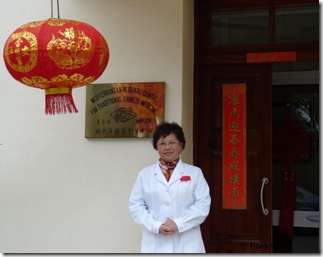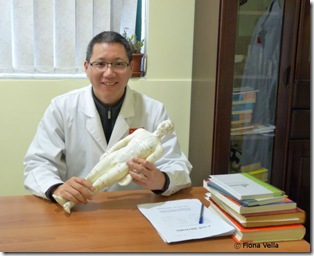-
The art of healthy living
For many Western societies, the idea of health is the absence of disease. Yet this is not the case in China. In fact, in China, the aspect of health incorporates within it the comprehensive system of a lifestyle which focuses on balance, harmony with nature, a good diet, the use of natural and medicinal herbs, regular exercise, massage, relaxation of the mind, body and soul, and other practices, amongst which is acupuncture. This art of healthy living, which today forms part of the national Chinese tradition, has evolved along thousands of years of experimentation and studies about health and longevity, which subjects have always been intriguing topics for all peoples. When I decided to explore this Chinese concept, I found myself immersed in a somewhat alien world, wherein the philosophy, the language, the diagnosis and the healing practices were totally different from those that I am used to. Therefore I chose to investigate this ancient font of wisdom by referring to who could help me understand better….
The Mediterranean Regional Centre for Traditional Chinese Medicine in Malta
The Mediterranean Regional Centre for Traditional Chinese Medicine in Malta is located in Kordin, Paola. It was established in 1994 as part of a project of cooperation between Malta and China. For these last 20 years, every 2 years, a new Chinese medical team is sent to this centre in order to replace the previous group, so that these doctors can offer their services from this place and also from Mater Dei hospital and the general hospital in Gozo.
The Director of the centre, Dr. Wang Xiaolan, informed me that the last medical team has arrived in Malta in July 2013. It consisted of 6 members, 4 of which are experts in traditional Chinese medicine. Dr Wang informed me that the attendance of the Maltese is increasing each year in this centre and by now they treat about 10,000 patients annually. In fact, in 2012, the Chinese government has made an investment of 400,000 euro in order to restore extensively this centre with the aim of increasing space and also to enhance the environment where the clients attend.
The philosophy of traditional Chinese medicine
I met Dr Xia Yong Jiang, an expert in traditional Chinese medicine, in one of the treatment rooms so that he could introduce me to this subject and also to show me some traditional Chinese practices.
We started the conversation by discussing how the Chinese philosophy regarded the concept of health, wherein in contrast to the Western system which generally focuses only on the painful or sick part of the body, the Chinese system looks at the person as a whole and at the environment in which he lives in order to understand better what could be the reason which is causing a state of ill health. This reasoning is based on the idea that a human being consists of a small world which exists in a larger world, and where any sudden changes in the big world will leave their effects on the individual’s health. Everything is based on the idea of harmony between man and nature, integrity between the body and the mind and the maintenance of a dynamic balance of life activities under the influence of the internal and external environments.
In the Chinese culture, health depends on the equilibrium between the yin and yang forces. According to this theory, just as everything under the sun has two sides, the shady and the sunny, likewise all things and phenomena in the world contain two opposite aspects: yin and yang, which are in conflict and at the same time mutually dependent. In the meantime, another fundamental theory establishes the principle of qi which states that everything which is alive, including man, has an element of natural energy within, and through it all actions and emotions are based. By means of a meridian system in man, qi together with blood, circulate around the human body. Moreover, this system which is constituted of 361 points, relates the internal organs to the superficial organs and tissues, making the body an organic whole.
Many Westerners might find this theory of qi somewhat difficult to comprehend and because of this same reason, they might not understand the concept behind acupuncture which involves the insertion of needles along the different meridian points. Meanwhile, it is believed that the origin of acupuncture may go back to prehistory as man started to study and experiment on his own body until he realized that if he introduced a pointed thing in a particular part of his body, he experience pain relief. Probably at this time very thin bones that were sharpened with stones were used. Some scholars even suggest the use of long porcupine spines. By time, this discovery continued to be developed until today one finds stainless steel needles which length varies between 13mm and 125mm.
Acupuncture
The main aim of acupuncture is to manipulate the flow of qi when this becomes blocked and therefore causes imbalance in the patient’s life. Different needles are used according to the need of the patient and these are stimulated in order to increase their effect. The various points from which qi flows are known as acupoints. There are three distinct areas where the needles are placed: the local point, the distant point, and the ashi point which marks the exact point of pain. In order for the doctor to locate these points, a diagnosis is made.
I have to admit that I am a person who has a very deep fear of needles and therefore the idea of acupuncture makes me uncomfortable. However, I must assure the readers that I have rarely seen any reactions of pain from patients during the insertion of these needles, even when these penetrate the face or the head! When I asked Dr Xia about how the Maltese react to the idea of acupuncture, he informed me that many of the clients who come to the centre have been recommended to go there by other friends who have experienced this practice and therefore they are already aware that there is nothing to be afraid of. On the other hand, he confirmed that with other clients who like me are terrified of needles or who have never known someone who has done acupuncture before, the doctor sits down and discusses what this practice is all about and what is its meaning, until the patient feels calm enough and ready to undergo this treatment.
During this interview I had the opportunity to talk to a client who was receiving acupuncture treatment. Kathy Williams explained how during her whole life, she had suffered from very severe migraines, which worsened even more when she reached her change of life. After attending to three sessions of acupuncture, Kathy expressed already a sense of relief from this pain. When I asked her whether she had been afraid of needles, she immediately told me that when you are in real pain, you would be ready to do anything in order to get healed. However she reassured me that the insertion of acupuncture needles is not painful. Kathy continued to describe that after each treatment she feels a bit unwell but on the next day she gets a fantastic feeling of well-being as the acupunture effects start to reflect on her body. She admitted that initially she had been skeptic and suspicious of how effective acupuncture might really be. Yet after she tried it, she believes that in the relief of pain, there is nothing better than acupuncture. Moreover, since this method uses natural healing, there are no side-effects, unlike common medicine.
The investigation of the body
During my interview with Dr Xia, I found out that the diagnosis of doctors who use the traditional Chinese medicine varies from that of Western doctors. In fact, these Chinese doctors start getting an immediate indication of what the client might be suffering from, even from their first glance at their patient. This takes place because the doctor observes the way that the client is walking, such as whether he is hurrying or walking slowly, and whether he moves in a straight or undulating way. Then doctors note the shape of the individual, whether he is thin or fat, the colour of his skin, his face expression, his posture and the way he speaks. The patient’s vitality is studied through the brightness of his eyes, from the colour of his lips and from the state of his hair. Certainly it was surprising to realize that these doctors give a lot of importance to the tongue too as this reflects the conditions of the internal organs, and so they study in detail its colour, its shape and its coating.
The investigation includes also auscultation which is done by listening to the patients’ voice, sounds of breathing, and coughing. In the old days, the diagnosis involved also olfaction which involved smelling the odour of the patient. Yet today this is somewhat difficult since people use many perfumes and this hides the personal odour of individuals. During this examination, the doctor also administers a type of pulse-taking which is unique to Chinese medicine, as the physician uses the index, middle and ring fingers. Eventually palpation of the body is done in order to determine the temperature, moisture and swelling. The abdomen is also checked and the patient is touched in order to identify the acupoints.
During this time, the doctor also discusses with the patient about his lifestyle, his diet, whether he practices some form of exercise and if he has any stressful atmosphere at home or at work. This practice takes place in order to see whether the patient is suffering from any sort of imbalance which is resulting in this pain.
Dr Xia insisted that it is very important that a good relationship is created between the patient and the doctor because this helps the treatments to be more effective. Indeed, I was very impressed when he informed me that prior to being sent to work in Malta, these Chinese doctors attend an eight month course in order to enhance their English language and also to learn about the Maltese culture, particularly about religion, so that they could communicate and understand better their Maltese clients!
Writing competition ‘Chinese Doctors through My Eyes’
As part of the celebrations of its 20th anniversary from its establishment, the Mediterranean Regional Centre for Traditional Chinese Medicine in Malta has launched a writing competition for its patients wherein it is inviting all amateur writers to write about their personal experience in this place. Features of not more than 1500 words can relate to Chinese doctors at the center whom the patients knew before, or stories about their treatments. Moreover, participants can present any photos which were taken at special occasions.
It is important that all the material is sent to the centre by means of the email mrctcm@gmail.com not as an attachment but as part of the body of the email. Details at the top of the email must also include the name, gender, occupation, address, email address and phone number.
The winning entries will be expected to be well-written, and have entertaining and accurate stories, ideally with a unique angle and a real sense of emotion. The winners will be awarded prizes at the reception for the 20th anniversary of the MRCTCM in April 2014. Although the official deadline for this competition was the 31st March 214, for the readers of this article, this date is being extended to 7th April 2014.
For more information one can contact the centre through Facebook on Mediterranean Regional Centre for Traditional Chinese Medicine or phone on 21691799.
(A Maltese version of this article was published in the series ĠABRIET IT-TIFKIRIET in Torċa dated 30th March 2014)
Category: Torca - Features & Articles | Tags:

